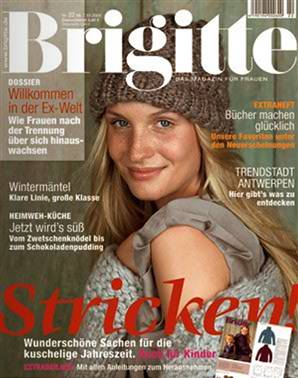BERLIN – Germany’s most popular women’s magazine announced Monday that it is banning professional models from its pages in favor of “real women” in an attempt to combat an unhealthy standard of rail-thin beauty that it says has isolated its readers.
The editor-in-chief of Germany’s bimonthly Brigitte told reporters that, starting next year, the magazine will feature a mix of prominent women and regular readers in photo spreads for everything from beauty to fashion to fitness.
Andreas Lebert said the move is a response to readers increasingly saying that they are tired of seeing “protruding bones” from models who weigh far less than the average woman.
“We will show women who have an identity – the 18-year-old student, the head of the board, the musician, the football player,” Andreas Leberts said in Hamburg, where the magazine, published by Gruner+Jahr, is based.
Fashion centers around the world have begun trying in recent years to combat the size 0 look that has come to dominate the fashion industry, contributing, some experts say, to eating disorders and poor body image.
In 2004, the Dove beauty products company launched its own “Campaign for Real Beauty” that included print and billboard ads showing “real women,” of all shapes and sizes, posing in their underwear.
In 2007, the U.S. Council of Fashion of Designers of America issued voluntary guidelines to curb the use of overly thin models.
Fashion officials in Madrid set a minimum body-mass index, and those in Milan tightened restrictions. Efforts gained urgency after 21-year-old Brazilian model Ana Carolina Reston died of anorexia in November 2006, weighing 88 pounds (40 kilos).
On its Web site, Brigitte announced to readers that “A New Epoch has Begun” and women to submit a portrait and full-body photos of themselves to considered for a photo shoot.
“We will pay the same fee as we would for professional models,” Lebert said, adding that the magazine views the move as an investment.
Lebert said his magazine’s move “should not be understood as a declaration of war on the modeling profession.”
“We are not going to become a magazine for plus-sizes,” he said.
Brigitte has suffered a steady drop in readers over the past 20 years but, with more than 719,000 copies sold per issue, it remains Germany’s most-read women’s magazine.
Louisa von Minckwitz, who owns the German-based Louisa Models agency, told The Associated Press she believed the ban on models was a marketing gag that would not last for long.
“Women want to see clothes on a beautiful, aesthetically pleasing person,” von Minckwitz said.
Associated Press Writer Zacharias Zacharakis contributed from Hamburg.
This article is copyrighted material, the use of which has not been specifically authorized by the copyright owner. We are making such material available in our efforts to advance understanding of environmental, political, human rights, economic, democracy, scientific, and social justice issues, etc. We believe this constitutes a ?fair use? of any such copyrighted material as provided for in section 107 of the US Copyright Law. In accordance with Title 17 U.S.C. Section 107, the material on this site is distributed without profit to those who have expressed a prior interest in receiving the included information for research and educational purposes. For more information go to: http://www.law.cornell.edu/uscode/17/107.shtml If you wish to use copyrighted material from this site for purposes of your own that go beyond fair use, you must obtain permission from the copyright owner.
I think its a good move to use women who are different to the modelling norm – after all we come in all shapes and sizes.
However as a naturally skinny person, I hate the term “real” women. A woman who is size 4 is just as “real” as a woman of size 22.
Other than that keep up the good work – great site!